What Is a White Label Solution? How It Boosts Your Business
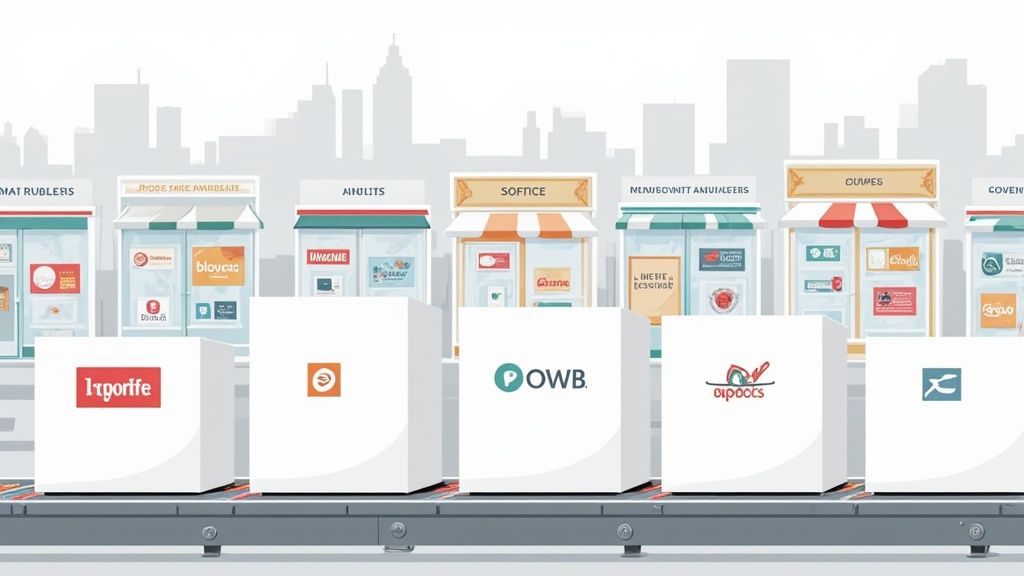
Ever heard of a white-label solution? It’s a pretty simple but powerful idea. Imagine a product or service that one company builds, but other businesses can slap their own branding on it and sell it as their own.
Think of it like this: a fantastic local bakery makes amazing, unbranded bread. Several nearby cafes buy that same bread, put it in their own custom bags with their logo, and sell it to their customers. The cafes get a top-notch product instantly without having to hire a baker or buy ovens. That's the white-label model in a nutshell—it lets you launch something new without building it from the ground up.
So, What Exactly Is a White Label Solution?
At its heart, a white-label solution is a strategic shortcut. Instead of pouring months (or even years) and a boatload of cash into research, development, and testing, a business can just buy a proven, ready-to-go product. This frees you up to focus on what you're actually good at: building your brand and talking to your customers.
You’ve almost certainly used a white-label product today and didn't even know it. That generic brand of cereal you picked up at the supermarket? It was probably made by a massive food manufacturer that also sells its own famous brands. Or how about the mobile app for your local credit union? Chances are, it's powered by a fintech company that provides the same underlying software to hundreds of other small banks.
How It Works in Practice
The whole process is a straightforward partnership between two main parties: the provider and the reseller.
- The Provider: This is the company that actually creates the generic product or service. They handle all the heavy lifting—the technical stuff, the maintenance, and all the future updates.
- The Reseller: This is you. You buy the rights to use the product, put your own spin on it with your logo, colors, and name, and then market it directly to your audience.
This image really breaks down the relationship, showing how a vendor’s core platform becomes a client’s branded product.
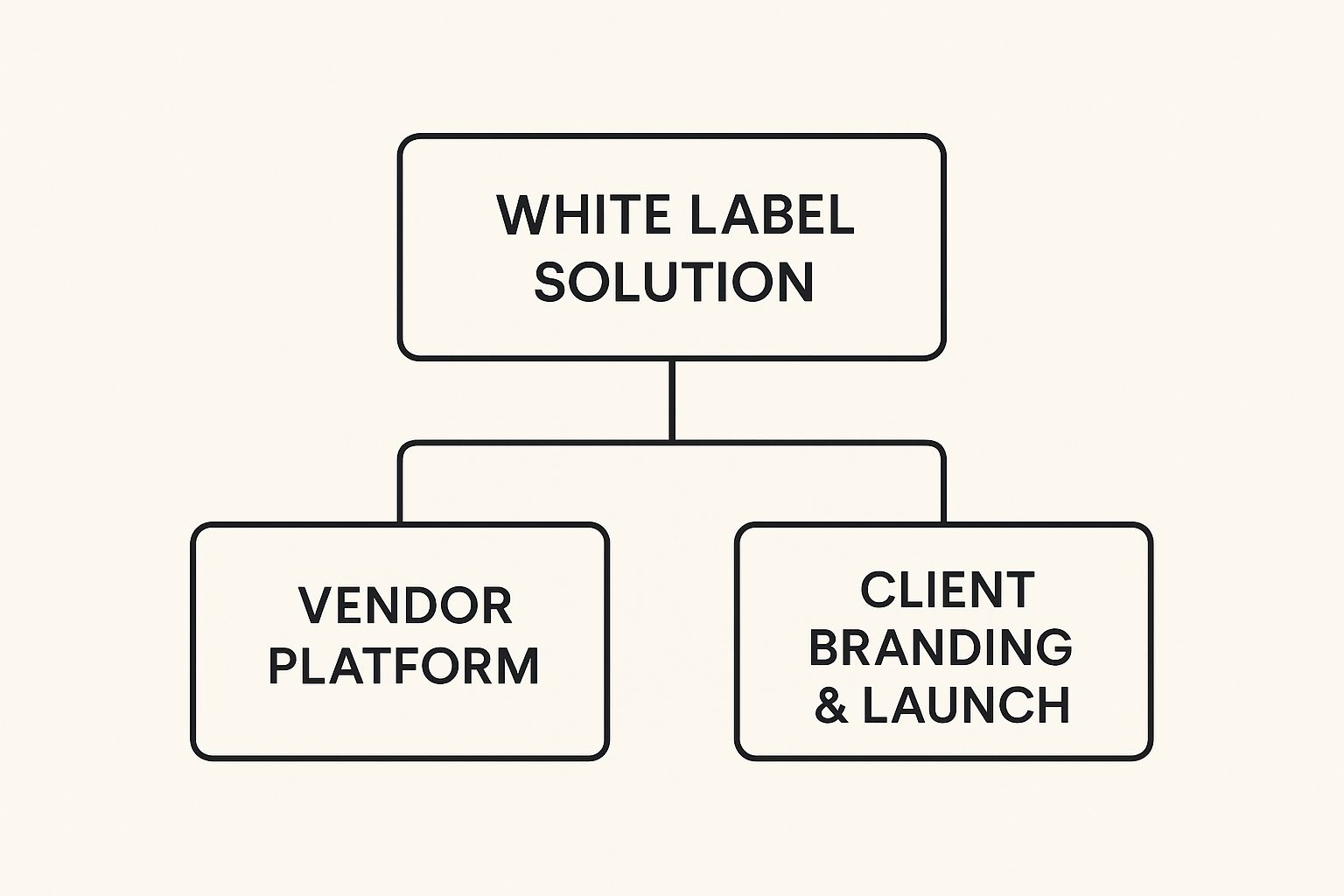
You can think of it like this: the provider builds the engine, and you get to design the car's cool exterior, pick the leather for the seats, and stick your badge on the hood before rolling it into the showroom.
White Label vs. Private Label vs. In-House
People often get these terms mixed up, but the distinctions are pretty important. A private label product is made exclusively for one single retailer (think Costco's Kirkland Signature). A white-label product, on the other hand, is sold to many different resellers. And building in-house is exactly what it sounds like—you create everything yourself from scratch.
A white label solution lets you stand on the shoulders of experts. You get a high-quality, tested product without the enormous risk and expense of in-house development, giving you an immediate competitive edge.
To make it even clearer, let's look at a side-by-side comparison of these three approaches. Each one has its own set of trade-offs when it comes to speed, cost, and control.
Comparing White Label vs Private Label vs In-House Development
| Attribute | White Label Solution | Private Label Solution | In-House Development |
|---|---|---|---|
| Speed to Market | Fastest. The product is already built and ready to be branded. | Slower. Requires collaboration on exclusive product specs. | Slowest. Requires a full development cycle from concept to launch. |
| Upfront Cost | Lowest. You're licensing an existing product, not funding its R&D. | Moderate. Costs are higher due to exclusivity and customization. | Highest. You bear the full cost of R&D, staffing, and infrastructure. |
| Control & Customization | Limited. Customization is usually confined to branding and visuals. | Moderate. You have input on features and specs, but don't own the IP. | Full. You have complete control over every aspect of the product. |
| Risk | Low. The product is already market-tested and proven. | Moderate. The product is unique to you, so there's some market risk. | High. You carry all the risk of product failure, bugs, and market fit. |
| Brand Differentiation | Good. You differentiate through your brand, marketing, and service. | Better. The product itself is exclusive to your brand. | Best. The product is 100% unique and fully aligned with your vision. |
Ultimately, the right choice really depends on your specific goals, your budget, and how quickly you need to get your idea out into the world. There’s no single "best" answer, just the best fit for your business.
So, What Are the Real Perks of Going White-Label?
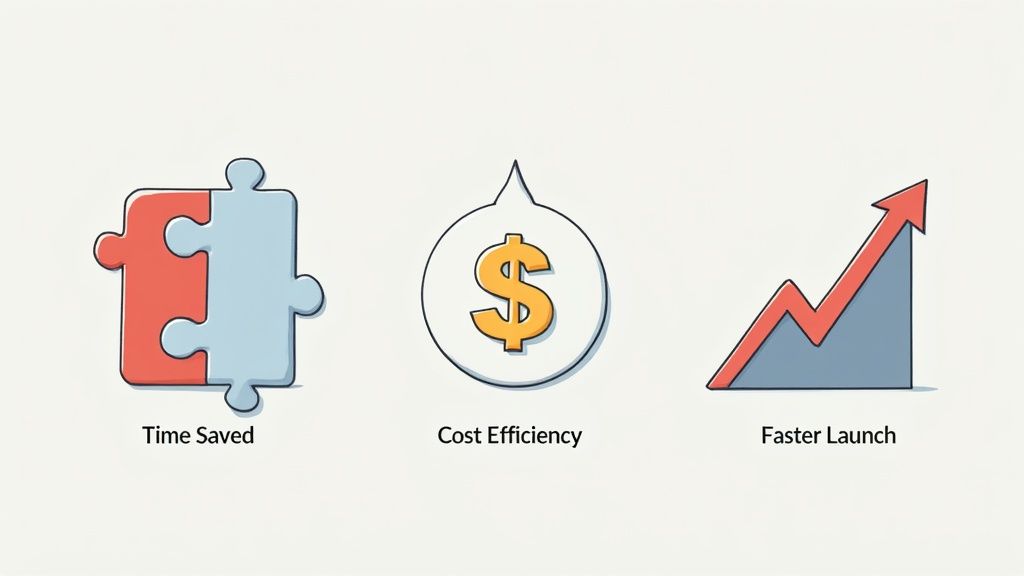
Okay, understanding the concept is one thing. But the real magic of a white-label solution is what it actually does for your business. Think of it as being handed a key that unlocks immediate growth, letting you sidestep the usual hurdles that bog down new projects. The biggest wins really boil down to saving time, cutting costs, and sharpening your focus.
Instead of getting stuck in a development cycle for months (or even years), a white-label product can get you live in a tiny fraction of that time. That speed is a massive competitive advantage. You can start bringing in revenue and getting real customer feedback while your competitors are still sketching things out on a whiteboard.
By using a pre-built, road-tested solution, you get to skip all the guesswork and avoid the financial black hole of building from scratch. It frees you up to concentrate on what makes your business unique: your brand, your marketing, and how you connect with your customers.
Get to Market in Record Time
This is the big one. The most obvious benefit is just how quickly you can launch. Building any product from the ground up is a long, winding road of research, design, coding, testing, and bug-fixing. A white-label solution has already done all of that heavy lifting.
You can roll out a new service in a matter of weeks, not years. This keeps your business agile and ready to jump on market trends and opportunities without being held back by a never-ending development timeline.
Slash Your Development Costs
Creating a new product, especially in the software world, is wildly expensive. You’re not just paying for developers and designers; you’re also on the hook for project managers, servers, maintenance, and endless updates. Building a custom app from zero can easily cost six figures just to get started.
A white-label solution lets you bypass those massive upfront costs entirely. You typically pay a much more predictable and budget-friendly licensing or subscription fee. This frees up a ton of cash you can then pour into other areas that actually grow your business, like:
- Marketing and Sales: Putting together a killer go-to-market strategy to get your first users.
- Customer Support: Building a top-notch support system that turns customers into fans.
- Brand Building: Investing in the things that make your brand memorable.
Focus on What You Do Best
Let's be real: unless you're a dedicated tech company, your expertise probably isn't in coding. Your strength is in knowing your customers, marketing your brand, and building a community. A white-label solution lets you lean into those strengths.
By handing off the technical side to an expert provider, you free up your team’s time and energy. You can focus on creating powerful marketing campaigns, like a well-designed community incentive program, that genuinely connect with your audience and get them excited. It’s a smart division of labor—let the product experts handle the product, while you handle the business. The end result is almost always stronger.
So, What Kinds of White-Label Solutions Are Out There?
When you hear “white-label solution,” your mind probably jumps straight to software. But that's just one piece of the puzzle. It’s better to think of it as a super-flexible business model that can apply to almost anything—from the coffee beans at your local cafe to the marketing tools an agency uses to wow its clients.
This adaptability is what makes it such a brilliant strategy for businesses that want to add new products or services without having to build everything from the ground up. Let's break down the three main flavors of white-labeling you'll see in the wild.
Physical White-Label Products
This is the old-school, tangible side of white-labeling. We're talking about physical goods made by one company, then rebranded and sold by another. You probably use these products every single day without a second thought.
Here are a few classic examples:
- Food and Beverage: Think about that local coffee shop you love. They might sell bags of beans with their cool logo on them, but chances are, a bigger, specialized roaster supplied the actual coffee.
- Cosmetics and Skincare: Ever wonder how so many influencers launch their own makeup lines so fast? They often team up with labs that have proven formulas ready to go. Just add branding and you're in business.
- Apparel: A small clothing boutique can buy high-quality, blank t-shirts in bulk, print their own unique designs on them, and suddenly have a custom fashion line without ever needing a factory.
White-Label Digital Services
Now we’re moving into the digital world. This is huge for agencies and consultants who want to offer more services without having to hire a whole new department. It lets them look like a full-service powerhouse by leaning on a partner behind the scenes to do the heavy lifting.
For example, a marketing agency might be great at social media but not so much at search engine optimization (SEO). Instead of turning clients away, they can partner with a specialized white-label SEO firm. That firm does all the technical work—audits, keyword research, reports—and the agency simply slaps its own logo on the final deliverables. It's a win-win.
This model is also common for content creation, ad campaign management, and more. For anyone in the Web3 arena, checking out a cryptocurrency affiliate program is another smart way to add a revenue stream by promoting related services under your own brand.
White-Label Software as a Service (SaaS)
This is where things get really exciting. White-label SaaS is easily the fastest-growing category, and for good reason. A business can license a fully developed piece of software, rebrand it as their own, and sell it to their customers. It’s a total game-changer, letting companies roll out a tech product without the eye-watering cost and time commitment of building it from scratch.
The market for this is exploding. The SaaS chunk of the white-label world is on a rocket ship, projected to hit an incredible $908.21 billion by 2030. That’s fueled by a compound annual growth rate of 18.7%, which just goes to show how many businesses are jumping on this model. If you want to dive deeper, you can read more about the future outlook of the white label market on whitelabelwonder.com.
Real-World Examples of White Labeling in Action
Theory is one thing, but seeing white-label solutions out in the wild is when it all really clicks. This isn't some niche strategy for a handful of companies; it's a powerful engine driving growth in some of the most competitive industries out there. From the makeup you see on Instagram to the payment app on your phone, white labeling is practically everywhere.
These real-world stories prove that using a pre-built product isn't a shortcut—it's a smart, strategic play. It lets new players jump into crowded markets and helps established businesses add new services without the massive risk and cost of building everything from the ground up.
The Beauty Industry Boom
The cosmetics world is a textbook example of white labeling at its best. Ever wonder how so many influencer-led makeup brands seem to pop up overnight with a full line of lipsticks, foundations, and eyeshadows? The secret is usually a white-label partnership.
Here's the inside scoop: these brands team up with specialized labs that have already perfected high-quality, unbranded formulas. The influencer or entrepreneur simply picks the products they like, slaps their own unique packaging and branding on them, and markets the line as their own. Just like that, they've sidestepped the need for expensive R&D and their own manufacturing facilities.
This model has blown the doors wide open for smaller, independent brands to go toe-to-toe with industry giants. The global white-label cosmetics market was worth about USD 1.01 billion in 2024 and is on track to hit USD 1.57 billion by 2030. A big reason for this growth? Customers want personalized and niche products, and white labeling makes that possible. You can dig into the numbers yourself in the full white label cosmetics market report on grandviewresearch.com.
This chart gives you a great visual of just how fast the white-label cosmetics market is growing.
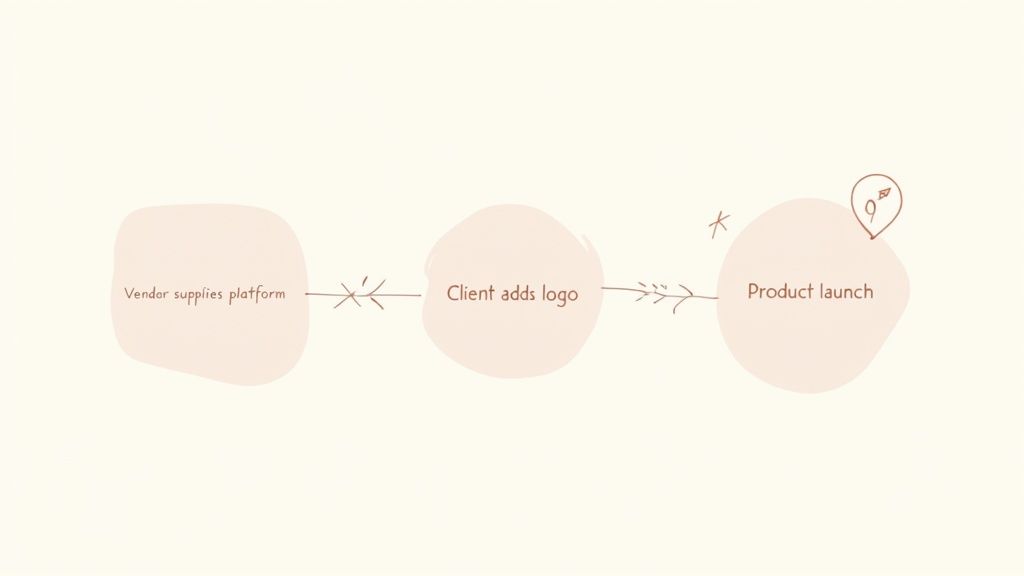
As you can see, the market is expanding at a steady clip, proving this isn't just a fad. It’s a sustainable and effective way for new brands to launch and scale up.
Powering the FinTech Revolution
Another industry where white-label solutions are making huge waves is financial technology, or FinTech. Let's be honest, building a payment gateway or a banking app from scratch is an absolute beast of a project. You’re talking about navigating complex security protocols, keeping up with endless regulations, and sinking millions into a secure infrastructure.
This is why many new FinTech apps dodge that headache by using a white-label payment gateway.
In FinTech, a white-label solution lets a company offer secure, branded financial services without actually having to become a bank. They get a proven, compliant system right out of the box and can focus all their energy on creating a killer user experience.
Here’s a quick breakdown of how it usually goes down:
- A new startup has a great idea for a branded debit card and mobile banking app.
- Instead of building the backend tech, they partner with a white-label FinTech provider.
- That provider handles the heavy lifting: the core technology for processing payments, managing accounts, and keeping everything secure.
- The startup just has to design the user interface, add its logo, and launch the app to its customers.
It's a classic win-win. The startup gets to market incredibly fast with a reliable product, and the provider gets to expand its reach. It’s a powerful approach that’s fueling a ton of the innovation we’re seeing in financial services today.
How to Choose the Right White Label Partner
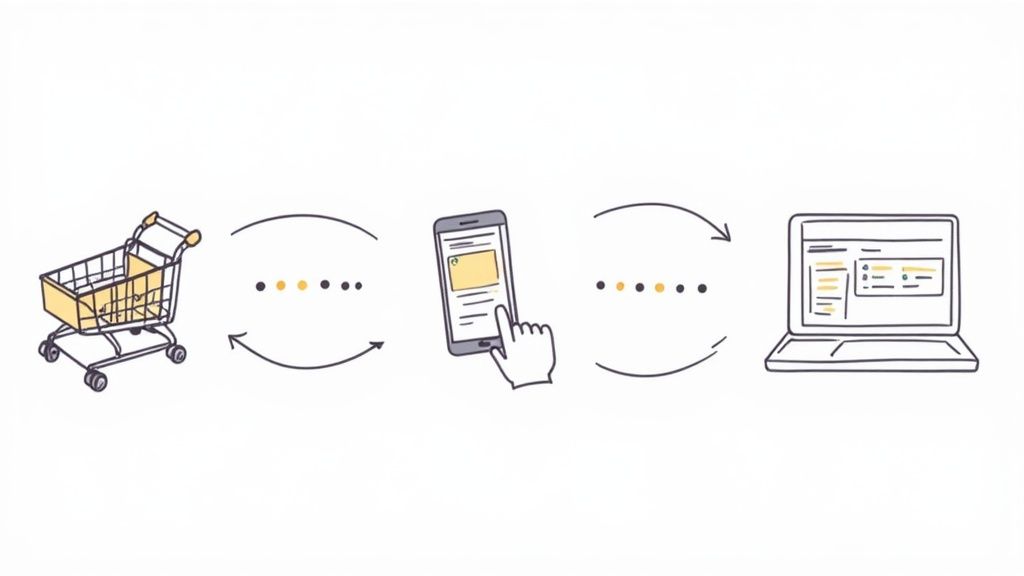
Finding a white-label product is the easy part. The real challenge—and the key to your success—is finding the right partner to stand behind it. This isn't just another vendor transaction; it’s more like hiring a critical extension of your own team. Their reliability, support, and vision directly shape your brand’s reputation and your ability to scale.
Making the right choice is about building a relationship that pushes your business forward, not one that drags you down. A great partner gives you a solid foundation to build on. A bad one? Well, that just leads to endless headaches and unhappy customers.
Evaluate Their Reliability and Support
Before you even think about signing a contract, you have to be absolutely sure the provider is rock-solid. Why? Because if their product glitches or their support team goes MIA, your customers will blame you, not them. Imagine your service crashing right in the middle of a huge marketing campaign. That’s the kind of nightmare an unreliable partner can create.
So, do your homework. Dig into their track record. Look for case studies, scour reviews, and don't be shy about asking for client references. Better yet, test their customer support for yourself. Shoot them a few technical questions before committing and gauge how quickly and helpfully they respond. How they treat a potential customer is a pretty good preview of how they'll treat you once you're on board.
Your white label partner is the invisible engine powering your brand. If that engine sputters, your customers won't blame the manufacturer—they'll blame you. Prioritize stability and responsive support above all else.
Assess Scalability and Customization
Your business isn't static, so your tools shouldn't be either. The perfect solution for your first 100 customers might buckle under the pressure of 10,000. You need a partner that can grow with you. Ask them straight up: How does your infrastructure handle a surge in demand? What does your product roadmap look like for the next year or two?
Customization is just as critical. While you can't change the core product, you need enough flexibility to make it look and feel like it belongs to your brand.
Here are a few key questions to get you started:
- Branding: How deep can we go with our logo, colors, and fonts? Is it just a logo swap, or can we truly make it our own?
- Integrations: Can this platform talk to the other tools we already rely on?
- Updates: How do you handle new feature rollouts? Will they disrupt our users' experience?
- Data Security: What are you doing to protect our company data and our customers’ private information?
Picking a partner is a long-term play. A thorough vetting process now ensures your investment pays off later, freeing you up to focus on growth. And knowing you have a reliable product is the first step in figuring out how to measure the ROI of your marketing efforts.
Got Questions About White Labeling? We've Got Answers.
Jumping into the world of white-labeling can feel a little confusing at first. It's a fantastic way to grow your business, but it's smart to get a handle on the details before you dive in. Let's walk through some of the questions that pop up most often.
White Label vs. Private Label: What's the Real Difference?
This is probably the most common question, and the answer boils down to one simple concept: exclusivity.
Think of a white-label product as a high-quality, ready-made template. A manufacturer creates a great product (like a software platform or a physical good) and lets dozens or even hundreds of other businesses put their own brand on it and sell it. It’s a one-to-many deal.
Private label, on the other hand, is a one-to-one relationship. This is when a company, like a major retailer, hires a manufacturer to create a product exclusively for them, often with unique specs. Think of the store brands at your local supermarket—those are classic private label products.
Simply put, white-labeling is like leasing a fantastic, universally compatible engine for your car. Private labeling is like commissioning an engineer to build a one-of-a-kind engine just for you.
Is White-Labeling Actually Legal?
Yes, 100% legal. White-labeling is a standard and well-established business practice all over the world. The whole thing is built on a formal agreement or contract between the company that makes the product and you, the reseller.
This contract gives you the legal green light to rebrand and sell their product as your own. A solid agreement is crucial, as it clearly lays out the rules of the road—what you can do, what you can't do, and how the partnership works. It’s a legitimate strategy that helps thousands of businesses expand their offerings without building from scratch.
How Much Can I Actually Change a White-Label Product?
This is a great question. Generally, customization is all about the branding. You'll almost always be able to swap in your own logo, apply your brand's color scheme, and tweak the visual style to make it feel like a natural part of your business. The goal is to give your customers a consistent, seamless experience.
Where you'll find limitations is in the core functionality. The provider has to maintain a single, stable product to serve all their clients, so they can’t build custom features for everyone. If your business absolutely needs a unique feature that isn't already on their roadmap, you might be better off exploring a custom-built solution. Always get a crystal-clear answer on customization options before you sign on the dotted line.
What Are the Downsides I Should Know About?
While the benefits are huge, it's not all sunshine and rainbows. It’s important to go in with your eyes open to the potential trade-offs. The biggest one is giving up some control. Since you don't own the underlying technology, you're relying on your provider for a few key things:
- Product Updates: You’re on their schedule for new features and improvements.
- Technical Support: When bugs pop up, it’s up to their team to fix them.
- Future Direction: Their vision for the product might not always line up perfectly with yours.
Another thing to consider is that your competitors could be using the exact same solution. This just means you have to work harder to stand out with amazing customer service, smart marketing, and a strong brand story. Lastly, if your provider goes out of business or runs into trouble, your offering is at risk. This is why doing your homework and picking a stable, reputable partner is the single most important decision you'll make.
Ready to launch a branded community experience without the development overhead? With Domino, you can create white-label portals for reward-based quests in minutes, not months. Accelerate user acquisition and engagement using our no-code Web3 toolkit. Learn more and get started today at domino.run.
Level Up Your dApps
Start using Domino in minutes. Use automations created by the others or build your own.
